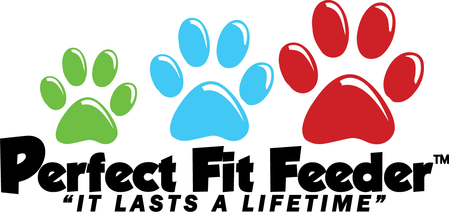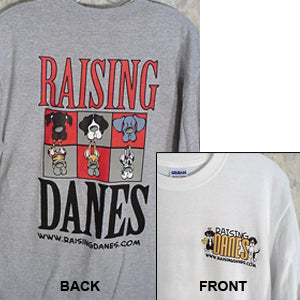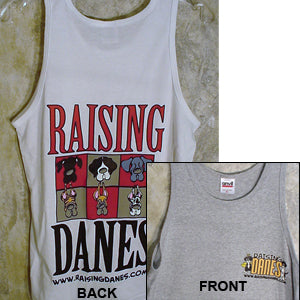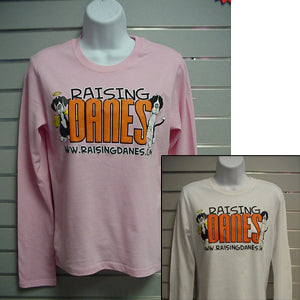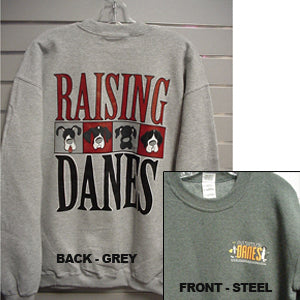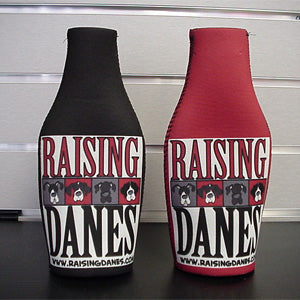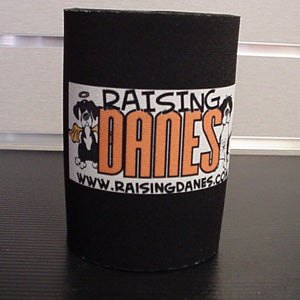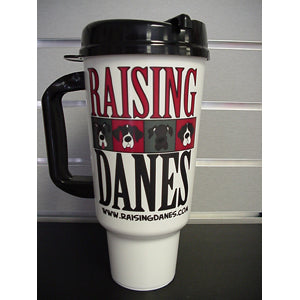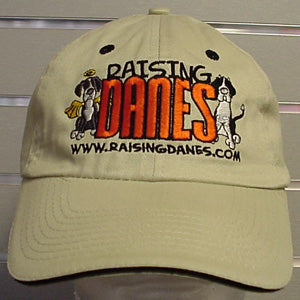Raising Danes Products

Check out our custom designed Raising Danes Apparel Collection. These designs were created straight from the heart. For many years, we have loved, rescued and helped our fellow rescue organizations find forever homes for Great Danes in need. It is out pleasure to share our love for this magnificent breed. We hope you enjoy these designs as much as we loved creating them.....
Danes 101- The Reality
This will not be your typical informational, history of or characteristics of, The Great Dane. This is reality as I know it. This is life with Great Danes as I know it. I am not an expert, a vet, a breeder, just a Dane Mom. This did not require a manual or a how to guide. This is simply my experience with Raising Danes.
In no way is this supposed to be a deterrent, simply the reality. PLEASE do your research and know this breed as we do BEFORE you take on the chore of Raising A Dane. More Danes are placed with rescue services because people simply don't do their homework. 3 out of my 4 Danes came to me via private surrenders, because the owners simply didn't know what they were getting themselves into. If I hear the words "well, the dog was getting so big" again, I just may scream..REALLY?? What part of Great Dane did you not understand? So, please continue reading if you are even considering this breed! For those of you who are already the proud parents of a Great Dane, you will enjoy this. I hope it makes you smile and nod your head as you read along. Enjoy!!
HISTORY OF THE GREAT DANE:
How many times have you heard these questions? Wow, is that a horse? Does it come with a saddle? Not a horse, no saddle. Contrary to popular belief, The Great Dane is not a descendant of the horse. The consensus among canine historians is that the Great Dane is actually a descendant of the Mastiff family. It is also believed that in Ireland, these Mastiff type dogs were bred with Irish Wolfhounds or Irish Greyhounds resulting in a taller, leaner, faster more chiseled German Mastiff or Great Dane. Then the breed was improved upon in Germany creating the true characteristics of the breed. It seems that the origin of the breed remains controversial and unsettled. Several countries claim the breed originated in their country. Of course they would. This is the "Apollo" of all dogs.
CHARACTERISTICS OF THE GREAT DANE:
SIZE: Ok, here we go. This is the scary part. YES, THEY ARE BIG!!
FACT: The Great Dane will grow to be a very large dog who takes up a considerable amount of space.
FICTION: The Great Dane needs an incredibly big house or big yard. Although it is a plus to have both, it is not absolutely necessary, however, keep in mind, such a large size makes the Great Dane an interesting conversation piece for sure, but it also presents a few obstacles. The space required for his sleeping and eating arrangements alone can take up a considerable amount of space. They require a large bed or they will take over yours. Our Danes actually have their own twin size beds, bordering ours of course, so we can actually sleep in our bed. They also require a raised feeding system or they will eat off your counters. TRUE! Rule of thumb to follow: If it is in Dane range, it is fair Dane! You will find that no matter how big your house or your yard is, your Dane will be attached to you at the hip. Literally in the way at every turn. These dogs are people dogs that require interaction and socialization. They do not do well simply being left alone in the house or in the yard. (we’ll get to that later) They do best when becoming part of the family and generally do best with a buddy. Great Danes are like potato chips. You can't have just one! They are very sensitive, emotional and can be very protective. For best results, make them a part of your every day routine and treat them like a part of your family.
It is important to consider not only their size but strength when deciding to add a Dane to your household. The Dane is know for "The Lean." This is quite possibly the highest form of affection a Dane can show you if you are prepared for it. It can also be quite a surprise if you are not. The entire weight of their enormous bodies, is now pushing on you, normally right around the knee or thigh area. Consider it a big Dane hug if you are prepared for it, however, if you are not, you can quite easily end up on the ground with them hovering over you, looking down at you, and saying What? Did I do that? Another thing to watch out for is the head on collision. If you see one or more of the pack heading your way, bend at the knees immediately! This is very important or you may be broken! Literally! Then there is the step. Watch your toes and feet or you could be missing one or it could feel broken. They really don't have any idea how big they are. This is agreed upon by ALL Dane owners I know.
The “Gentle Giant” reputation can be quite misleading in these cases as it still hurts when one steps on you, leans into you, hits you in the wrong spot with their enormous tails or runs into you with full force. Chances are you will be the one injured. Gotta love it!
One more important trait I’d like to point out as a Dane characteristic, is “The dig.” Great Danes have enormous paws thus creating a shovel system or even, as in Titan’s case, the back hoe. They can dig a hole big enough to burry you in, in mere seconds. As this can be quite helpful while landscaping, digging a pond, or on a construction site, it is not so helpful around the back yard. Watch your sep or you may find yourself in an enormous hole!
THE HUMAN TOWEL: Face it. You have now become their personal towel. Life with a Dane comes with lots of drool, slobber, snot, eye buggers, and dirt. All of these things will now be on your walls, floors, furniture but especially on YOU! You can’t run, you can’t hide. Just one shake of their enormous heads and it’s all over but the changing. They also love to do what I call, “the crotch rub.” That seems to be a favorite with my Danes. You walk into a room, all ready for the day, and one comes at you. Head right to the crotch, sharing everything in that special spot. You have now been DANED! Out the door you go sporting that special treat from your Dane. Guys, I know this can be real special for you at times. OUCH!!
It is also lots of fun when they share their drink with you. Head goes deep into the water dish, slopping and slobbering as much water as possible. Then it’s like they think, “How’s about a little kiss?” They head your way, drool and slobber hanging a mile long. Then smooch! You now have shared a drink. Whatever you do, don’t leave your drink unattended. It will sure to be full of sand, slobber, and whatever else they may have found along the way.
FOOD REQUIREMENTS: How much do they eat? Just like people, this may vary. Generally, the Great Dane goes through growing and eating spurts during the developmental stage. Great Danes grow until they are 18 months to 2 years of age. You will see the food consumption vary quite a bit during this time. We have 3 Great Danes and average about 40lbs of food a week. Sometimes a little more and sometimes less. They will eat when they are hungry. I'm not going to get into "what to feed your Great Dane." You will ask 10 people this question and get 10 different answers. They can be quite finicky eaters so you may have to try different types of food to find what works best for your dog. It is NOT recommended to feed this breed lots of "people" food unless it is a special raw diet. Great Danes are prone to allergies and skin irritations and the ingredients found in "people" food can contribute to these problems considerably. Lots of Danes do very well on a raw diet. However this is an expensive food program to manage. Please do your research and come up with a diet that is suitable to you and your Dane.
One of the most important things to know about feeding is that it is recommended to use a raised feeding system. Although this is still debated among Dane authorities, whoever they are, we’ve always found the raised system easier to reach for our Danes, easier to clean up underneath the feeder and easier on their posture and stance. Some will say raised bowls might encourage dogs to gulp air with their food which can possibly contribute to bloat. Stainless steel bowls are recommended because they are easier to clean, unbreakable, and do not harbor bacteria. This is one of those things that you will have to consider and decide your reasons for using a raised system. Keep in mind, what goes in, will come out. Land mines as we like to call them.
HEALTH CHALLENGES IN THE BREED: This is the hard part! Breed clubs and health surveys in the US and the UK put the average life span of Great Danes at 6 - 8 years. However, it seems that good breeding standards, good medical care and awareness of the owners have resulted in longer, healthier lives. We are hearing 12 years and 14 years now. That is amazing! Great Danes, like most giant dogs, have a fairly slow metabolism. This results in less energy and less food consumption per pound of dog then in small breeds. Great Danes have some health problems that are common to large breeds, including gastric dilatation-volvulus (GDV, a painful distending and twisting of the stomach). This is a critical condition that can affect Great Danes and other deep-chested breeds, and which may cause death if not quickly addressed. Drinking large amounts of fluid in a short period of time can provoke GDV in Great Danes. It is commonly recommended practice for Great Danes to have their stomachs tacked (Gastropexy) to the right of the abdominal wall, to prevent this problem. Especially if the dog has or its relatives have a history of GDV also known as bloat, though, bloat may precede the development of GDV. Your Great Dane should refrain from exercise or high activity immediately before and after meals. Immediate veterinary evaluation should be sought if a dog demonstrates ANY signs of this condition. Signs that GDV may have occurred include, but are not limited to, visible distension (enlargement of the abdomen) and repeated retching that resembles repetitive non-productive attempts to vomit.
Another problem common to the breed is hip dysplasia. Typically an x-ray of the parents can certify whether their hips are healthy and can serve as a guideline for whether the animals should be bred and are likely to have healthy puppies.
Wobblers disease can also be a problem in this breed. This condition consists of unstable neck vertebrae that put pressure on the spinal cord and cause the dog to lose some coordination. It is generally gradually progressive and usually first appears in dogs under 2 years of age. It is thought to be inherited and though there is treatment, prognosis is usually guarded. Milder cases often respond well to anti-inflammatory medications and alternative therapies.
Dilated Cardiomyopath (DCM) and many congenital heart diseases are also commonly found in the Great Dane, in conjunction to the shorter lifespan. They can also suffer from several genetic disorders that are that are specific to the breed.
Endocrine Disorders can also be common in this breed. The endocrine system performs an amazing balancing act as it regulates hormone levels throughout the body. Hormones affect the function of organs within the body, and when the endocrine system doesn’t work properly, all kinds of internal mayhem can occur. Both Addison’s disease, (we experienced this first hand with our Abby), and hypothyroidism are considered autoimmune diseases. They occur when the dog’s own immune system attacks and destroys the hormone-producing glands and leaves their function impaired. Damaged glands are irreparable, and affected dogs must receive hormone supplements for the duration of their lives. There are several good reference books and web sites that will guide you through the treatment options. It is imperative to diagnose and treat these diseases immediately. Although the prognosis for treated dogs is good, treatment for Addison’s can be quite expensive. Thankfully, treatment of Hypothyroidism is quite inexpensive.
|
THE COLOR CHART: One of the most delightful features of the Great Dane is the colors in which they come. All of these color options are attractive in their own right and complement the other remarkable traits of the breed. Please note: this is simply a guideline and may not represent the exact descriptions determined by the AKC. I simply want to outline the incredible color chart available. I am certainly not an expert as my Danes would be considered “undesirable” based on the AKC show standards. I like to say my Danes may not be show Danes, just Mommies Danes! There are six show-acceptable coat colors for Great Danes: Please note this is the AKC guidelines for show dogs. We do not show our Danes, but find this color chart helpful to distinguish between the different colors of this fine breed.
FAWN: The color is yellow gold with a black mask. Black should appear on the eye rims and eyebrows and my appear on the ears.
BRINDLE: The color is fawn and black in a chevron stripe pattern. Often also they are referred to as having a tiger-stripe pattern.
BLUE: The color is a pure steel blue. White markings at the chest and toes are not desirable and considered faults.
BLACK: The color is a glossy black. White markings at the chest and toes are not desirable and considered faults.
HARLEQUIN: The base color is pure white with black torn patches irregularly and well distributed over the entire body. A pure white neck is preferred The black patches should never be large enough to give the appearance of a blanket, nor so small as to give a stippled or dappled effect.
MANTLE: The color is black and white with a solid black blanket extending over the body, black skull with white muzzle, white blaze is optional, whole white collar preferred, a white chest , white on part or whole or forelegs and hind legs, white tipped black tail. A small white marking in the black blanket is acceptable as is a break in the white collar. Often referred to as Boston's due to the similar coloration and pattern as a Boston Terrier.
Other colors occur occasionally but are not acceptable for conformation showing and are not pursued by breeders who intend to breed show dogs. These colors include white, fawnequin, merle, merlequin, fawn mantle and others. Some breeders may attempt to charge more for puppies of the "rare" colors, however the breeding of white and merle Danes is particularly controversial as these colors may be associated with genes that produce deafness. Although they cannot be shown, white or merle Danes can usually still be registered as pedigree dogs. |
